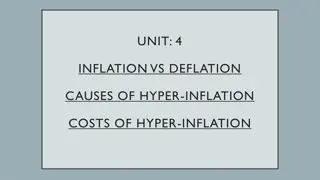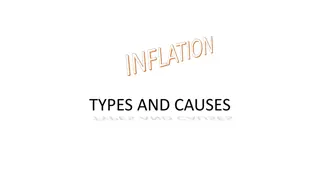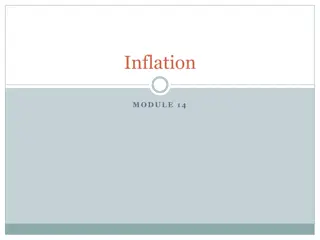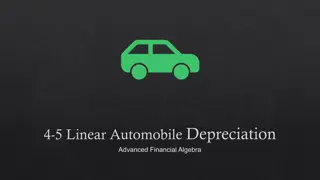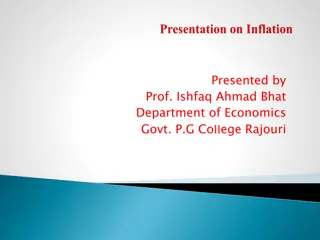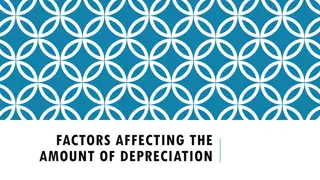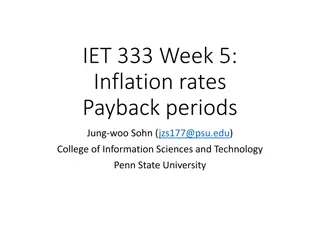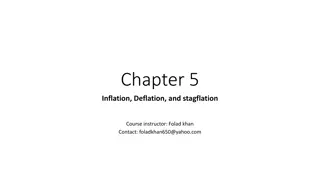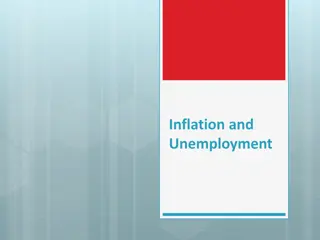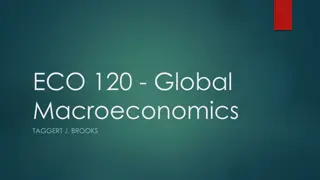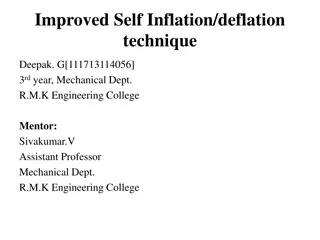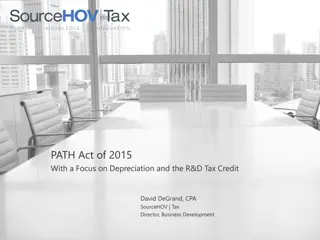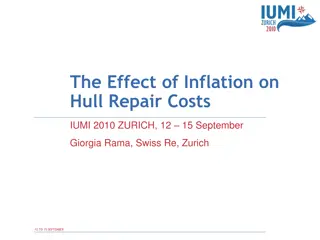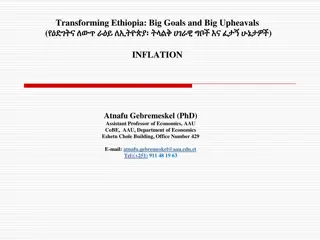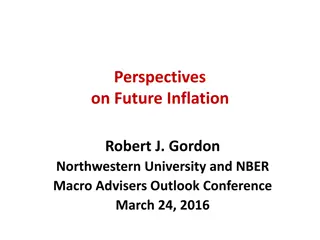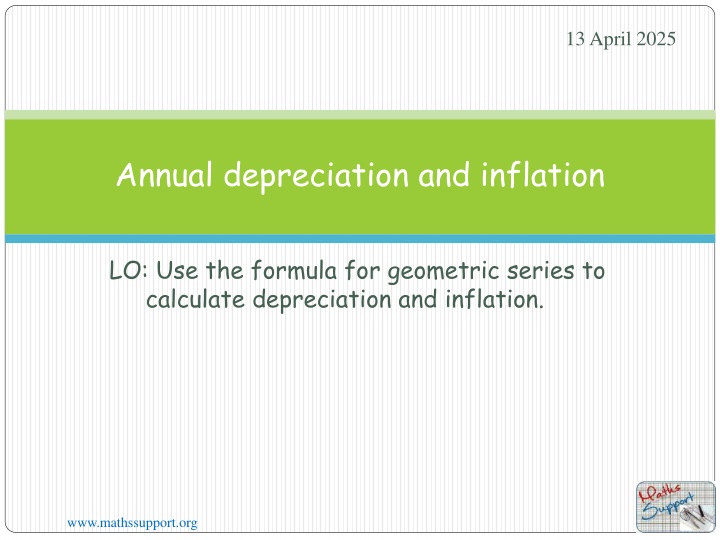
Depreciation and Inflation in Economics
Learn how to calculate depreciation and inflation using geometric series formulas. Explore the impact of inflation on prices of goods and assets over time. Example scenarios show the effects of inflation on purchasing power and asset values.
Download Presentation

Please find below an Image/Link to download the presentation.
The content on the website is provided AS IS for your information and personal use only. It may not be sold, licensed, or shared on other websites without obtaining consent from the author. If you encounter any issues during the download, it is possible that the publisher has removed the file from their server.
You are allowed to download the files provided on this website for personal or commercial use, subject to the condition that they are used lawfully. All files are the property of their respective owners.
The content on the website is provided AS IS for your information and personal use only. It may not be sold, licensed, or shared on other websites without obtaining consent from the author.
E N D
Presentation Transcript
13 April 2025 Annual depreciation and inflation LO: Use the formula for geometric series to calculate depreciation and inflation. www.mathssupport.org
Depreciation and inflation Prices of goods and commodities change, usually upwards. The money in your pocket is likely to have less buying power in two years time than it does now. This effect is called Inflation Governments tend to keep measures of inflation because the level affects peoples happiness and hence their choice of government The measure is commonly called the consumer price index (CPI). The CPI is a percentage increase for prices over a given time period. www.mathssupport.org www.mathssupport.org
Depreciation and inflation Inflation To calculate inflation, you can use the formula for compound interest ( n ) r FV = PV 1 + 100 www.mathssupport.org www.mathssupport.org
Inflation When calculating inflation, the annual multiplier is ( n ) r Where r is the annual inflation rate as percentage. 1 + 100 The inflation formula is: ( n ) r FV = PV 1 + 100 Where: FV is the future value after n years PV is the original value r is the inflation rate as percentage, per year n is the number of years www.mathssupport.org
Inflation From December 2012 to December 2013 the Australian Bureau of Statistics recorded a CPI of 2.7%. If one kg of local cheese cost 9.65 AUD in December 2012, how much did it cost in (a) Dec. 2013 (b) Dec. 2014 (c) Dec 2016 The original value is 9.65 AUD and inflation ratio 2.7% ( 1 ) 2.7 100 After 1 year, the value is: (a) FV = 9.65 1 + 9.65 1.027 = 9.91 2.7 100 ( ) 2 After 2 years, the value is: FV = 9.65 1 + (b) 9.65 1.027 2= 10.18 FV = 9.65 1 + ( ) 4 2.7 100 After 4 years, the value is: (c) 9.65 1.027 4= 10.73 www.mathssupport.org
Inflation Georgia would like to purchase a painting that is currently worth $5000. She makes monthly deposits into an investment account, so that she can purchase the painting in 3 years time. If inflation averages 2.5% per year, calculate the value of the painting indexed for inflation for 3 years. To index the value of the painting for inflation, we increase it by 2.5% each year for 3 years ( ) 3 2.5 100 Indexed value is: 1 + = 5000 = 5 000 1.0253 = 5384.45 www.mathssupport.org
Depreciation and inflation Depreciation is the loss in value of an asset over time. Assets such as computers, cars, and furniture depreciate for two reasons: Wear and tear For example, an auto will decrease in value because of the mileage, wear on tires, and other factors related to the use of the vehicle. Obsolescence. Assets also decrease in value as they are replaced by newer models. Last year's car model is less valuable because there is a newer model in the marketplace.. www.mathssupport.org www.mathssupport.org
Depreciation and inflation Depreciation To calculate depreciation, you can use the formula for compound interest but the rate will be negative instead ( n ) r FV = PV 1 - 100 www.mathssupport.org www.mathssupport.org
Depreciation When calculating depreciation, the annual multiplier is ( n ) r Where r is the annual depreciation rate as percentage. 1 - 100 The depreciation formula is: ( n ) r FV = PV 1 - 100 Where: FV is the future value after n time periods PV is the original value r is the depreciation rate per period n is the number of periods www.mathssupport.org
Depreciation A car is bought for 25 000, and depreciates at 15% each year. Find its value after (a) 1 year (b) 2 years (c) n years We have that the initial value is 25 000 and depreciation ratio is 15% After 1 year, the value is: (a) ( 1 ) 15 100 FV = 25000 1 - 25 000 0.85 = 21 250.00 ( ) 2 15 100 After 2 years, the value is: (b) FV = 25000 1 - 25 000 0.852= 18 062.50 After n years, the value is: (c) 25 000 0.85n www.mathssupport.org
Depreciation ( n ) r FV = PV 1 + 100 An excavator was purchased for 12 000 and depreciated at 18% each year. (a) Find its values after 7 years. (b) By how much it depreciate? ( n ) 18 100 r FV = PV 1 + PV = 12 000 100 -18 ) r = n = ( 7 FV = 12 000 1 7 FV 2 991.43 FV = ? So, after 7 years the value is 2 991.43 2 991.43 = 9 008.57 Depreciation = 12 000.00 So, depreciation is 9 008.57 www.mathssupport.org
Using a GDC for depreciation Leslie paid $ 32 000 for a new car. The car depreciates at a rate of 12% per annum. Find its values after 5 years. We are going to use Graphing display calculator to solve the problem CASIO CASIO www.mathssupport.org
Using a GDC for depreciation Leslie paid $ 32 000 for a new car. The car depreciates at a rate of 12% per annum. Find its values after 5 years. We are going to use the Financial feature From the Main Menu select Financial EXE www.mathssupport.org
Using a GDC for depreciation Leslie paid $ 32 000 for a new car. The car depreciates at a rate of 12% per annum. Find its values after 5 years. We are going to use the Financial feature From the Main Menu select Financial EXE Select F2: Compound interest www.mathssupport.org
Using a GDC for depreciation Leslie paid $ 32 000 for a new car. The car depreciates at a rate of 12% per annum. Find its values after 5 years. We are going to use the Financial feature From the Main Menu select Financial EXE Select F2: Compound interest n: represents the number of time periods I%: represents the interest rate per year PV: represents the present value PMT: represents the payment each time period FV: represents the future value P/Y: is the number of payments per year C/Y: is the number of compounding periods per year 5 EXE www.mathssupport.org
Using a GDC for depreciation Leslie paid $ 32 000 for a new car. The car depreciates at a rate of 12% per annum. Find its values after 5 years. We are going to use the Financial feature From the Main Menu select Financial EXE Select F2: Compound interest n: represents the number of time periods I%: represents the interest rate per year PV: represents the present value PMT: represents the payment each time period FV: represents the future value P/Y: is the number of payments per year C/Y: is the number of compounding periods per year 5 EXE -12 EXE www.mathssupport.org
Using a GDC for depreciation Leslie paid $ 32 000 for a new car. The car depreciates at a rate of 12% per annum. Find its values after 5 years. We are going to use the Financial feature From the Main Menu select Financial EXE Select F2: Compound interest n: represents the number of time periods I%: represents the interest rate per year PV: represents the present value PMT: represents the payment each time period FV: represents the future value P/Y: is the number of payments per year C/Y: is the number of compounding periods per year 5 EXE -12 EXE -32 000 EXE www.mathssupport.org
Using a GDC for depreciation Leslie paid $ 32 000 for a new car. The car depreciates at a rate of 12% per annum. Find its values after 5 years. We are going to use the Financial feature From the Main Menu select Financial EXE Select F2: Compound interest n: represents the number of time periods I%: represents the interest rate per year PV: represents the present value PMT: represents the payment each time period FV: represents the future value P/Y: is the number of payments per year C/Y: is the number of compounding periods per year EXE 5 EXE -12 EXE -32 000 EXE 0 0 EXE EXE 1 EXE 1 www.mathssupport.org
Using a GDC for depreciation Leslie paid $ 32 000 for a new car. The car depreciates at a rate of 12% per annum. Find its values after 5 years. We are going to use the Financial feature From the Main Menu select Financial EXE Select F2: Compound interest n: represents the number of time periods I%: represents the interest rate per year PV: represents the present value PMT: represents the payment each time period FV: represents the future value P/Y: is the number of payments per year C/Y: is the number of compounding periods per year 5 EXE -12 EXE -32 000 EXE 0 0 EXE EXE 1 EXE EXE 1 F5 www.mathssupport.org
Using a GDC for depreciation Leslie paid $ 32 000 for a new car. The car depreciates at a rate of 12% per annum. Find its values after 5 years. The value after 5 years is: $16 887.42 www.mathssupport.org
Thank you for using resources from A close up of a cage Description automatically generated For more resources visit our website https://www.mathssupport.org If you have a special request, drop us an email info@mathssupport.org www.mathssupport.org


